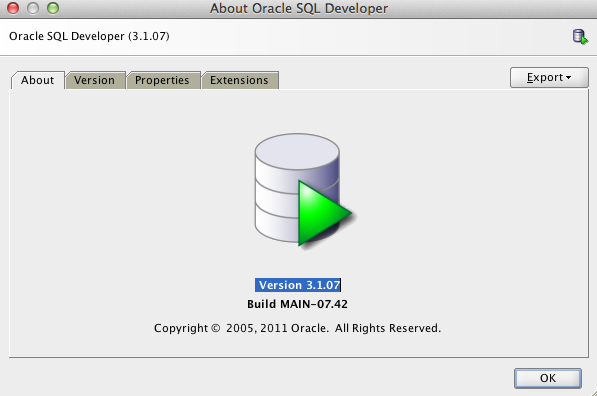
Your entries from tnsnames.ora should now display here. Select TNS as connection type in the drop down box. Now in SQL Developer right click on Connections and select New Connection.
#Oracle sql developer tools windows#
profile file in your home directory.Ĭonfirm the os is recognizing this environmental variableįrom the Windows command line: echo %TNS_ADMIN% In Linux, define the TNS_ADMIN variable in the. In Windows, this is done by navigating to Control Panel > System > Advanced system settings > Environment Variables. If your tnsnames.ora file is not getting recognized, use the following procedure:ĭefine an environmental variable called TNS_ADMIN to point to the folder that contains your tnsnames.ora file.

LocalMachine\SOFTWARE\ORACLE\ORACLE_HOME_KEY SQL Developer will look in the following location in this order for a tnsnames.ora file Select row_number() over (partition by col_num,col_date,col_varchar order by col_num) rn,t.This excellent answer to a similar question (that I could not find before, unfortunately) helped me solve the problem. Select 'In T2 but not in T1' diff,s.* from ( Select row_number() over (partition by col_num,col_date,col_varchar order by col_num) rn,t.* from t2 t Select row_number() over (partition by col_num,col_date,col_varchar order by col_num) rn,t.* from t1 t Select 'In T1 but not in T2' diff,s.* from ( The column used in the order by clause does not matter in terms of functionality All columns need to be named in the partition by clause, it is not possible to just say 'partition by *' Insert into t2 values (null,null,'I am in T2 only with nulls') Insert into t1 values (null,null,'I am in T1 only with nulls') Insert into t2 values (null,null,'I am in both with nulls') Insert into t1 values (null,null,'I am in both with nulls') I am taking care of duplicate rows by numbering them using row_number() and then comparing the numbered rows: - TEST TABLESĬreate table t1 (col_num number,col_date date,col_varchar varchar2(400)) Ĭreate table t2 (col_num number,col_date date,col_varchar varchar2(400)) The accepted answer does not take this into account which would give you wrong results in case of duplicates. NOTE: In steps 3 & 4 is where you would select the differing schemas in which the objects exist that you want to compare.įourth - If the tables two tables you wish to compare have more columns, are in the same schema, have no need to compare more than two tables and are unappealing to compare visually using the DESCR command you can use the following to compare the differences in the table structure: selectĪ.data_precision || ' | ' || b.data_precisionīelow is my solution - taking into account that the diffed tables can have duplicate rows.Select the "Standard Object Types" you want to compare.Third - If you are using Oracle SQL Developer, and you want to compare the table structure of two tables using different schemas you can do the following: Oracle SQL Developer is great as a simple tool for developers.


Toad for Oracle is very useful for complex data management, and this includes monitoring queries and managing permissions. If you only want to see the differences in the data between the two tables, then as mentioned by several others, using the SQL Minus operator should do the job. Oracle SQL Developer, in comparison to Toad for Oracle, works very similarly. Second - The first solution may not be ideal for larger tables with a lot of columns. In addition to some of the other answers provided, if you wanted to look at the differences in table structure with a table that might have the similar but differing structure, you could do this in multiple ways:įirst - If using Oracle SQL Developer, you could run a describe on both tables to compare them: descr TABLE_NAME1


 0 kommentar(er)
0 kommentar(er)
